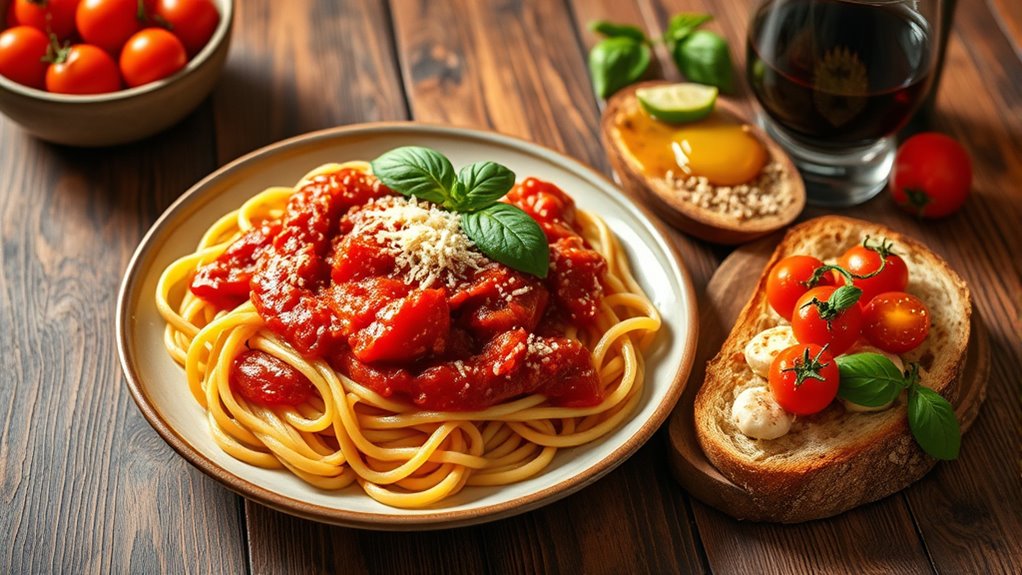To enjoy the rich flavors of Italian cooking, focus on fresh, seasonal ingredients like ripe tomatoes, fragrant herbs, and high-quality cheeses. Simple techniques such as gentle sautéing and slow simmering bring out natural tastes while minimal seasoning allows each ingredient to shine. Balancing acidity, sweetness, and salt creates vibrant, harmonious dishes. If you explore further, you’ll discover how tradition and freshness make Italian cuisine truly unforgettable.
Key Takeaways
- Fresh, seasonal ingredients like tomatoes, herbs, and cheeses highlight natural flavors and authenticity.
- Simple seasonings and proper techniques enhance ingredient quality without overwhelming taste.
- Balance of acidity, sweetness, saltiness, and bitterness creates harmonious, vibrant dishes.
- Emphasis on local, seasonal produce ensures peak flavor and supports tradition.
- Respect for tradition and minimal spices define Italian cuisine’s focus on freshness and simplicity.

What makes Italian cooking so irresistibly flavorful? It’s a combination of fresh ingredients, simple techniques, and a deep respect for tradition. When you step into an Italian kitchen, you immediately sense the emphasis on quality. Bright tomatoes, fragrant herbs, creamy cheeses, and extra-virgin olive oil all come together to create dishes that are both comforting and vibrant.
Italian cuisine isn’t about complicated recipes; it’s about highlighting the natural goodness of each ingredient. This approach guarantees that every bite bursts with authentic flavor, making each meal feel like a celebration of the senses.
The secret to Italian flavors lies in the balance and harmony of ingredients. You’ll notice that dishes often have a perfect blend of acidity, sweetness, saltiness, and bitterness. For example, fresh basil and oregano add aromatic brightness, while garlic and onions build a savory foundation.
When you cook pasta, it’s not just about boiling water and tossing in sauce—it’s about creating a symphony of flavors, where each component enhances the other. That’s why Italian sauces like marinara or pesto are so rich—they’re built layer by layer, with attention to detail and quality.
Another key element is how Italian cooking emphasizes seasonal and local ingredients. You’re encouraged to use what’s fresh and available, whether it’s ripe tomatoes in summer, hearty root vegetables in winter, or fragrant herbs in spring. This seasonal focus guarantees that flavors are at their peak, making your dishes more vibrant and memorable.
Plus, the use of simple seasonings like salt, pepper, and a splash of olive oil allows the ingredients’ natural flavors to shine through. You don’t need heavy spices or complicated marinades—just trust the ingredients and let their fresh taste take center stage.
Cooking techniques also play an essential role. You might simmer a sauce slowly over low heat to develop depth, or gently sauté vegetables to preserve their delicate flavors. These methods maximize the natural qualities of each ingredient, resulting in dishes that are rich yet balanced.
In addition, the use of authentic ingredients is fundamental to achieving true Italian flavors, as it ensures the dishes retain their original character and depth.
Whether you’re making a creamy risotto or a crispy pizza, the focus is on precision and patience. This respect for proper technique enhances the flavors, ensuring each dish is more than just satisfying—it’s unforgettable.
In essence, Italian cooking’s irresistible flavors come from a philosophy that values freshness, simplicity, and harmony. You’re not just preparing food; you’re crafting a sensory experience rooted in tradition.
When you embrace these principles, you’ll find that every meal becomes an authentic taste of Italy, full of warmth, richness, and timeless appeal.
Frequently Asked Questions
What Are the Key Regional Differences in Italian Cooking Flavors?
You’ll notice that Italian cooking varies greatly by region. In the north, you get creamy dishes with butter and cheese, like risottos and polenta.
In the south, bold flavors dominate, with lots of olive oil, tomatoes, and herbs.
Sicily features seafood and sweet pastries, while Tuscany highlights simple, rustic ingredients like fresh vegetables and grilled meats.
These regional differences create the diverse, vibrant flavors that make Italian cuisine so unique.
How Do Italian Chefs Balance Acidity and Sweetness in Dishes?
You might think balancing acidity and sweetness is as simple as a pinch of sugar or splash of vinegar, but Italian chefs play a delicate game.
They taste and adjust with finesse, often adding a touch of honey or a squeeze of lemon to find harmony. It’s a culinary dance where too much of one ruins the melody, and mastery lies in knowing exactly how to blend these contrasting notes seamlessly.
What Authentic Italian Herbs Are Essential in Traditional Recipes?
You want to know which authentic Italian herbs are essential in traditional recipes. Basil stands out for its aromatic sweetness, especially in sauces like pesto. Oregano adds a robust, slightly bitter flavor to tomato-based dishes. Rosemary offers a piney aroma perfect for roasted meats.
While thyme provides earthy notes for soups and stews. Parsley brightens dishes with its fresh, mild flavor. These herbs are fundamental in creating genuine Italian flavors.
How Does Italian Cuisine Incorporate Seasonal Ingredients?
You might think Italian cuisine is all about rich sauces, but it’s also about embracing seasonal ingredients. You’ll see fresh tomatoes in summer, hearty greens in winter, and tender asparagus in spring.
What Is the History Behind Italy’s Most Iconic Flavor Combinations?
You might wonder about Italy’s iconic flavor combinations, which have deep historical roots. These pairings often evolved from regional ingredients and ancient trade routes, blending local herbs, cheeses, and meats.
For example, basil and tomato became a staple in Southern Italy, while sage and pork are popular in the North. You’ll notice these timeless combos reflect Italy’s diverse landscapes and culinary traditions, showcasing centuries of flavor innovation.
Conclusion
As you savor the rich flavors of Italian cooking, you’re invited to experience a symphony of tastes that dance on your palate like a lively festa. Each ingredient, carefully chosen, weaves together a story of tradition and passion. So, let your kitchen be your passport, and every dish a journey through Italy’s heart. Embrace these flavors, and watch as they turn simple moments into unforgettable memories, like a warm hug from Italy itself.









